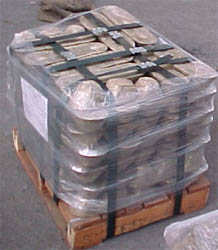Bronze: The Alloy
 |
|
Bronze is stronger and harder than any common alloy other than steel. |
Bronze is an alloy made primarily of copper and tin. It may contain as much as 25 percent tin. Phosphorus, lead, zinc, and other metals may be added for special purposes. For example, phosphorus hardens and strengthens the alloy.
Bell bronze is an alloy of about 80% copper and 20% tin— for millennia, this has proven to be the optimum alloy, with just the right combination of hardness and resonance, to make a beautiful sounding and long lasting bell.
The term bronze was originally applied only to alloys of copper and tin, but because of the reputation of bronze for hardness and durability, the term has been adopted commercially for many copper-rich alloys that contain little or no tin but are similar in color to bronze, including aluminum bronze, manganese bronze, and silicon bronze. Some quality brass alloys have been incorrectly called bronze. However, when the word bronze is used by itself, the alloy should contain considerable tin.
The strongest bronze alloys contain tin and a small amount of lead. Tin, silicon, or aluminum are often added to bronze to improve resistance to corrosion. As bronze weathers, a brown or green film forms on the surface. This film inhibits corrosion. Bronzes have a low melting point, a characteristic that makes them useful for brazing-that is, for joining two pieces of metal.
Bronze weighs about 4.71 ounces per cubic inch. Lesser grades can contain some zinc or other metals; if zinc, the resulting properties are closer to brass.
Properties and uses.
As mentioned, the hardest and strongest bronze contains much tin and little lead. Alloys with a high tin content also have a low melting point. This low melting point proved to be the nemesis of Russia's great Tsar-Kolokol— often thought to be the biggest bell in the world although it's actually a little smaller than Burma's Mingun Bell— which cracked during a fire in the Kremlin before it could ever be raised from its casting pit. But such bronzes are also preferred for intricate ornamental castings such as statues. When bronze is to be used for this purpose, lead is often added to the alloy. The result is a cheaper alloy that is easier to cut. Lead is not added, of course, to bells, because it would both weaken the alloy and deaden the sound.
Lead is added to bronze, however, when the manufactured article will need to be lubricated. For example, bearings are often made from leaded bronze. Bronze that contains only phosphorus and tin wears best against steel when no lubricating agent is used.
Because it is easily cast in large shapes, bronze is often used in making bells. It also has special sound-damping and resonating characteristics that give a rich tone.
Most bronze alloys resist corrosion. Statues and bells made of bronze will weather to a beautiful brown color or develop a green patina (film) characteristic of copper. After such a film forms, bronze corrodes very slowly. Because of this, bronze articles last hundreds of years.
Bronze alloys that contain as much as 10 percent tin are widely used in wrought form, in which the metals are hammered or beaten into shape. Or, they are first cast and afterward shaped by rolling or drawing to produce rods, wires, sheets, or tubing. When they are hardened by cold working, these alloys make excellent springs. They are commonly used where corrosion or electrical resistance make the use of steel undesirable. The electrical industry makes wide use of such bronze. Sometimes the red brasses are substituted, but they are not as satisfactory.
Silicon and aluminum bronze
Silicon and aluminum bronze are more difficult to cast and fabricate than are the tin bronzes. But they are excellent copper-base alloys with special properties that make them useful. Silicon bronze is copper alloyed with 1 percent to 3 percent silicon. Then about 1 percent iron, nickel, or manganese is added. Silicon bronze has great resistance to corrosion from strong chemicals and is used for chemical containers. Aluminum bronze may contain 5 percent to 10 percent aluminum and as much as 5 percent of iron, nickel, or manganese. Some aluminum bronzes can be heat-treated and hardened until they are as strong as steel.
The sound test
If you tap a piece of metal lightly with a pencil or some small, hard object like a pebble or a coin and listen carefully, here's what you will hear:
Zinc: Thud
Brass: Faint dull ringing
Bronze: Clear ringing tone
(For best results, tap a sculpture on the end of an arm. For a plaque, hold by a corner, and tap the opposite corner. Tap a bell just on the lip, near the bottom of the bell, or where the clapper strikes the inside of the bell (the "sound bow").)
Clearly, for acoustic purposes, bronze is the most favorable alloy.